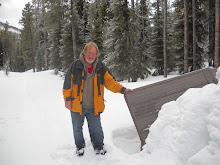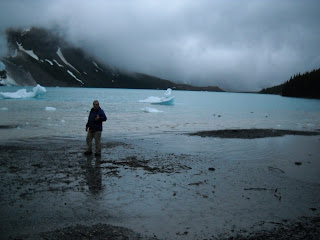

June 30, 2011, Day 4 of Mount Robson Park, Berg Lake Hike.
To get to the Hargrave Lake trail head requires hiking back along the Berg Lake trail for about 1.6 km. The weather was a little better on this day and I think we made our breakfast under the Tyvek Fly. Even though we had some clear sky and sunshine the top of Mount Robson was still shrouded in clouds. Jim and I started our hike at 8:30 AM.
As Jim and I hiked back along the Berg Lake trail I happened to notice 5 Harlequin Ducks loafing on a rock. We stopped to observe them and I was even able to take a photo and a video of them. Then we noticed a few more loafing on a rock near the first one. There were 10 ducks in total.
I had hiked the Mum Basin and Toboggan Falls in June 2001 with Jim and Ken but we did not get to Hargrave Lake on that hike.
Once we started on the Hargrave Lake trail it was a steady climb. The Berg Glacier is a calving glacier meaning that chucks of ice break off and fall into the lake to form Icebergs on the lake. On the way up there was a loud rumble of a Berg breaking. I immediately looked and saw broken chunks of ice tumbling down the edge of the glacier and seconds later I heard a secondary rumble. I kept wondering why I hadn't seen larger chucks breaking off. Later in the day while at the Mum Basin I heard a loud rumble of breaking ice and when I looked at the lake I noticed new icebergs in the lake and waves radiating outward from the toe of the glacier. This confirmed what I had been thinking, which was simply that light travels faster than sound. By the time I heard the sound of the rumble of the breaking ice the event was already over as it would have taken several seconds for the sound to reach me. The waves on the water validated that a calving event had occurred within those seconds of time.
Much of the hike to Hargrave Lake is along the Lateral Moraine left as the glacier shrank in size. I speculate that when the distance between the two lateral moraines were filled with ice the Hargrave Glacier would have been as large in width and length as the Athabasca glacier is now. Walking along the moraine gives one a commanding view of Berg Lake, Hargrave Lake, and the glaciers all framed in rocky slopes and craggy mountains. As Jim and I reached the view point for Hargrave Lake we were over taken two younger hikers. One was a student of geology at the U of A. The other was an engineering student at Bristol University.
We then decided to continue on up to the cave. This is a steady ascent. We saw 2 eagles soaring over the ridge high above us. There were more people at the cave and they went into the cave. Jim and I stayed outside as their description of the interior of the cave was sufficient for us. We had a few snacks here and a bit of a rest. It was very enjoyable visiting with other hikers. The trail from the cave to the Mum Basin is not well defined but it was sufficiently clear for us to follow, however this might not be so had there been any snow or perhaps even on a day with low contrast light. The alpine flowers were out in abundance. A white crocus like flower was just one of many. A person could easily spend many pleasant hours with reference book in hand identifying flowers. There was a significant amount of 'old' snow on the trail but not enough to impede our progress in any way. Where signs of the trail were masked by the snow then there were tracks of the hikers who had been there before us to guide the way.
We then decided to continue on up to the cave. This is a steady ascent. We saw 2 eagles soaring over the ridge high above us. There were more people at the cave and they went into the cave. Jim and I stayed outside as their description of the interior of the cave was sufficient for us. We had a few snacks here and a bit of a rest. It was very enjoyable visiting with other hikers. The trail from the cave to the Mum Basin is not well defined but it was sufficiently clear for us to follow, however this might not be so had there been any snow or perhaps even on a day with low contrast light. The alpine flowers were out in abundance. A white crocus like flower was just one of many. A person could easily spend many pleasant hours with reference book in hand identifying flowers. There was a significant amount of 'old' snow on the trail but not enough to impede our progress in any way. Where signs of the trail were masked by the snow then there were tracks of the hikers who had been there before us to guide the way.
As we descended from the Mum Basin we saw a Clark's Nutcracker. Seeing it served to refresh my memory about the differences between the Clark's Nutcracker and the Gray Jay or Whiskey Jack.
At some point during our descent to the Robson Pass Campground Jim loaned me one of his walking poles. I found it to be a help went descending steeper trails.
We were back at camp by 3:30 pm.
Total distance hiked: 12.1 km
moving 4 hr.s 20 min
sopped 2 hr 34 min
total ascent 3355 ft.
Max. elevation 7037 ft.
My notes for June 25, 2001 record that we did the Mum Basin hike in fog and snow. During lunch we observed 2 marmots playing and also an eagle soaring above us. I also mentioned the abundance of flowers including the white crocus.




